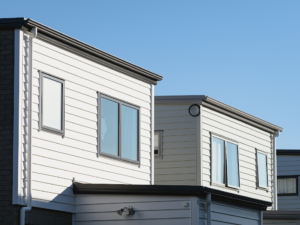Flooring options, such as wood floor laminate and hardwood are two of the most popular choices among homeowners. Each type of flooring has unique advantages and drawbacks, and deciding between the two is significant. Understanding the differences, benefits, and potential downsides of wood floor laminate and hardwood can help you make an informed choice that suits your home’s needs and personal preferences.
Understanding Wood Floor Laminate
Wood floor laminate, often simply called laminate flooring, is a synthetic product of multiple layers fused through a lamination process. The top layer is a high-resolution photographic image of wood covered with a clear protective layer, making it look like real wood.
Composition and Construction
Laminate flooring typically consists of four layers: a wear layer, a design layer, an inner core layer made of high-density fiberboard, and a backing layer. The wear layer is resistant to scratches and stains, making laminate a durable option for high-traffic areas. The design layer gives a laminate wood-like appearance, while the core layer provides stability and strength. The backing layer adds moisture resistance and additional stability.
Installation Process
One of the biggest advantages of laminate flooring is its ease of installation. Laminate planks interlock, allowing for a floating floor installation without needing nails or glue. This feature makes laminate an ideal choice for DIY enthusiasts. Additionally, laminate can be installed over most existing floors, provided they are clean, dry, and level.
Cost Considerations
Laminate flooring is generally more affordable than hardwood. The cost can vary based on the quality and brand, but laminate provides a budget-friendly option for those looking to achieve a wood-like appearance without the higher price tag of real wood.
Exploring Hardwood Flooring
Hardwood flooring is made from real wood, which is milled from a single piece of timber. This type of flooring is known for its natural beauty, durability, and the value it can add to a home. Hardwood floors come in various species with unique grain patterns and colors.
Types of Hardwood
There are two main types of hardwood flooring: solid hardwood and engineered hardwood. Solid hardwood is made from a single piece of wood and can be sanded and refinished multiple times, making it a long-lasting choice. Engineered hardwood consists of a thin layer of real wood on top of a core made of plywood or high-density fiberboard, providing greater stability in environments with fluctuating humidity levels.
Installation Methods
Installing hardwood flooring is typically more complex than installing laminate. Solid hardwood requires nailing or stapling to a subfloor, while engineered hardwood can be installed as a floating floor or glued down. Professional installation is often recommended for hardwood to ensure proper placement and longevity.
Durability and Maintenance
Hardwood floors are highly durable and can last for decades with proper care. They are susceptible to scratches and dents, but these can often be sanded out and refinished. Sweeping, vacuuming, occasional damp mopping and other regular maintenance can keep hardwood floors looking beautiful.
Comparing Aesthetics and Style
The visual appeal of your flooring can significantly impact the overall look and feel of your home. Both laminate and hardwood offer a variety of styles, but there are key differences in their appearance and the ambiance they create.
Natural Beauty of Hardwood
Hardwood flooring is prized for its natural beauty and unique grain patterns. Each plank has its distinct look, giving your floor a one-of-a-kind appearance. The rich, warm tones of hardwood can add elegance and sophistication to any room, making it a popular choice for living rooms, dining rooms, and bedrooms.
Versatility of Laminate
Laminate flooring offers a wide range of designs, including those that mimic exotic wood species and other natural materials like stone and tile. Advances in technology have made laminate floors look more realistic than ever before. This versatility allows homeowners to achieve a variety of styles and looks at a fraction of the cost of real hardwood.
Consistency and Uniformity
While hardwood’s natural variations appeal to many, others prefer the consistency of laminate flooring. Each laminate plank looks the same, providing a uniform appearance that can be particularly attractive in modern or minimalist home designs.
Evaluating Performance and Longevity
When investing in new flooring, it is crucial to consider how well it will perform and how long it will last. Both laminate and hardwood have strengths and weaknesses in these areas.
Durability of Laminate
Laminate flooring is known for its durability, especially in high-traffic areas. The wear layer protects against scratches, stains, and fading, making it an excellent choice for homes with pets and children. However, laminate is less resistant to moisture and can be damaged by excessive water exposure.
Lifespan of Hardwood
Hardwood floors can last a lifetime with proper care. They can be sanded and refinished multiple times, restoring their original beauty even after years of use. Hardwood’s ability to be refinished makes it a more sustainable choice in the long run, as it can adapt to changing design trends and wear over time.
Resistance to Environmental Changes
Compared to solid hardwood, engineered hardwood offers better resistance to environmental changes, such as humidity and temperature fluctuations. Laminate flooring also performs well in various conditions, but extreme humidity can cause the planks to swell or warp.
Environmental Impact and Sustainability
Another important consideration is the environmental impact of your flooring choice. Laminate and hardwood have different implications for sustainability and environmental responsibility.
Sustainability of Hardwood
Hardwood flooring can be a sustainable option when sourced from responsibly managed forests. Look for certifications such as the Forest Stewardship Council (FSC) to ensure the wood is harvested sustainably. Hardwood’s long lifespan and refurbishing ability contribute to its sustainability.
Eco-Friendliness of Laminate
Laminate flooring can also be eco-friendly, especially made from recycled materials. However, the production process involves synthetic materials and adhesives, which can have environmental impacts. Some laminate manufacturers prioritize sustainability by using eco-friendly practices and low-emission adhesives.
Recyclability and Disposal
Both hardwood and laminate have different disposal considerations at the end of their life cycles. Hardwood can be recycled or repurposed, whereas laminate is more challenging due to its composite materials. Considering the end-of-life options for your flooring can help reduce environmental impact.
Comfort and Acoustic Properties
The comfort and acoustic properties of your flooring can affect the overall feel of your home. Each type of flooring offers different benefits in these areas.
Comfort Underfoot
Hardwood flooring provides a natural, warm feel underfoot. Its solid structure offers a comfortable surface, especially with proper underlayment. While generally harder and less forgiving, laminate can be installed with padded underlayment to improve comfort.
Acoustic Performance
Hardwood floors can contribute to noise levels in a home, as they tend to amplify sound. Area rugs and proper underlayment can help mitigate this issue. With its synthetic core, laminate flooring often provides better sound insulation, making it a quieter option for busy households.
Temperature Regulation
Both hardwood and laminate can affect the temperature of your home. Hardwood floors can feel cooler in the winter and warmer in the summer, while laminate stays at a more consistent temperature year-round. The choice of underlayment and the presence of radiant heating systems can also influence temperature regulation.
Room Suitability and Application
Different rooms in your home may require different flooring solutions. Understanding the suitability of laminate and hardwood for various spaces can help you make the best choice.
High-Traffic Areas
Laminate flooring is an excellent choice for high-traffic areas like hallways, kitchens, and entryways due to its durability and resistance to scratches and stains. Hardwood can also be used in these areas but may require more maintenance to keep it looking its best.
Moisture-Prone Areas
Laminate flooring is generally not recommended in areas prone to moisture, such as bathrooms and basements, due to its susceptibility to water damage. Engineered hardwood can be better if properly installed and maintained in these spaces.
Aesthetic Preferences
Consider the aesthetic preferences for each room. For example, hardwood’s natural beauty can enhance the elegance of living and dining rooms, while laminate’s versatility can complement a wide range of styles in bedrooms and home offices.
Resale Value and Market Perception
The type of flooring you choose can impact your home’s resale value and how it is perceived in the market. Both laminate and hardwood have different effects on property value.
Perceived Value of Hardwood
Hardwood flooring is often associated with luxury and high quality, making it a desirable feature for potential buyers. Homes with hardwood floors can command higher prices and attract more interest in the real estate market.
Cost-Effective Appeal of Laminate
While laminate flooring may not have the same perceived value as hardwood, it offers a cost-effective solution that can still enhance the appeal of your home. High-quality laminate can look remarkably similar to hardwood, providing an attractive option for budget-conscious buyers.
Longevity and Investment
Investing in hardwood flooring can be seen as a long-term benefit, given its durability and ability to be refinished. Laminate flooring, while less expensive upfront, may need to be replaced sooner, affecting its long-term value proposition.
Maintenance and Care Requirements
The maintenance and care required for your flooring choice can influence your decision. Both laminate and hardwood have specific care needs that should be considered.
Cleaning Laminate Flooring
Laminate flooring is relatively easy to clean and maintain. Regular sweeping or vacuuming and occasional damp mopping are usually sufficient to keep laminate floors looking their best. However, excessive water should be avoided, as it can cause the laminate to swell or warp.
Maintaining Hardwood Floors
Hardwood floors require more meticulous care to maintain their appearance. Regular cleaning with a soft broom or vacuum is necessary, and spills should be wiped up promptly to prevent staining. Periodic refinishing can restore the beauty of hardwood floors and extend their lifespan.
Handling Repairs
Repairs for laminate flooring typically involve replacing damaged planks, which can be straightforward if you have extra pieces from the original installation. Hardwood repairs may involve sanding and refinishing, which can be more labor-intensive but often results in a seamless restoration.
Final Thoughts on Choosing Between Laminate and Hardwood
Choosing between laminate and hardwood flooring depends on various factors, including your budget, lifestyle, and aesthetic preferences. Both options have their unique advantages and considerations, making it essential to weigh these aspects carefully before making a decision. Hardwood offers timeless beauty and long-term value, while laminate provides a cost-effective and durable alternative. Ultimately, the best choice for your home will align with your needs, the specific requirements of each room, and your overall vision for your living space.
For more insights and expert advice on home improvement projects, visit our Build All Construction Inc. blog.







